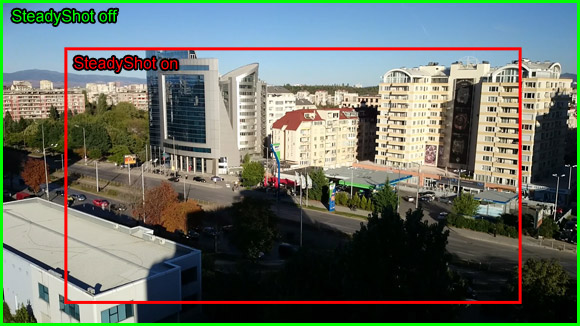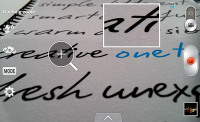Six-way camera shootout: Smartphone roulette
Smartphone roulette
Video camera features
As with the still camera, the video recording capabilities can again be divided into software and hardware features. Hardware features describe the integrated recording capabilities allowed by the hardware (like 4K video recording) while software features encompass the extras provided by the user interface.
| Samsung Galaxy Note 3 | LG G2 | Sony Xperia Z1 | Nokia Lumia 1020 | Apple iPhone 5s | HTC One | |
| Maximum front/rear video resolution | 4K (2160p) rear; 1080p front | 1080p rear; 1080p front | 1080p rear; 1080p front | 1080p rear; 720p front | 1080p rear; 720p front | 1080p rear; 1080p front |
| Audio stream | Stereo, 128Kbps | Stereo, 156Kbps | Stereo, 156Kbps | Stereo, 256Kbps | Mono, 64Kbps | Stereo, 192Kbps |
| High framerate video | 1080p@60fps; 720p@120fps | 1080p@60fps | No | No | 720p@120fps | 720p@60fps |
| Lossless zoom | 2x | - | - | 4x | - | - |
| Dual shot camera recording | Yes | Yes | No | No | No | No |
| Audio zoom | Yes | Yes | No | No | No | No |
| Camera/camcorder mode toggle | No | No | Yes | Yes | Yes | No |
| Stabilization | Digital | Optical | Digital | Optical | Digital | Optical |
| Still image while recording | 8MP | 1MP | 2MP | - | 2MP | 2MP |
| HDR Video | Yes | No | Yes | No | No | Yes |
| Other | Animated photo | Live effect, Tracking Zoom | - | Cinemagraph | - | Zoe |
Again the Nokia Lumia 1020 comes out pretty strong in terms of hardware offerings. We went over its camera sensor in detail in the still image section, so here we'll focus on what the 41MP sensor can do in terms of video recording.
The Lumia 1020 has some heavy duty optical image stabilization (OIS) under the hood, which should give shake-free videos in tricky conditions without sacrificing field of view. There's also the stereo WDR microphones, which along with the proprietary Rich Audio Recording algorithms from Nokia gives you distortion-free sound recording in loud environments. The Lumia 1020 is also the only smartphone in our test that offers 4x lossless zoom.
The 8MP shooter on the Apple iPhone 5s is capable of the standard 1080p video at 30fps, and it also has a 120fps video mode at 720p for capturing slow-motion clips. The digital image stabilization comes at the cost of a narrower field of view compared to the rest, but the result is quite impressive and better than some devices with OIS. It's a pity that you have no option for switching the feature off for those cases when you have a tripod or something to rest your hands against as you'd be able to get the full filed of view of the camera.
The Samsung Galaxy Note 3 is among the plethora of droids featuring 13MP shooters, but is the only device in this shootout to feature 4K (2160p) video recording. The larger sensor allows for up to 2x lossless zoom in 1080p videos, after which point things switch to digital zoom (more on this later). Its fullHD videos are also available in 60fps flavor - a feature that only the G2 can match.
The 20.7MP sensor found on the Sony Xperia Z1 was highly-vaunted prior to its release, and is the largest you'll find on an Android-powered smartphone. Maximum recording is at 1080p at 30fps, and while Sony's digital image stabilization algorithm SteadyShot performs well, it does so at a huge expense to the FoV.The good news is that unlike Apple, Sony gives you the option to switch SteadyShot off.

The Xperia Z1's SteadyShot comes at a significant cost to sensor real estate
The 13MP sensor on the LG G2 is very similar in terms of specifications to the one found on the Galaxy Note 3, offering the same 60fps recording at fullHD (but no 2160p recording). The G2 offers OIS, but the digital stabilization on the Note 3 is so good that the G2 is only able to beat it just barely (again at the price of narrower FoV, though).
Finally, the HTC One enters into the equation with its 4MP sensor and optical image stabilization, as well as HDR video recording (at significantly reduced field of view).
While many manufacturers have similar extras for still images, when it comes to features thrown into the recording interface things can vary widely. Here we'll point out some of the major ones.
The Samsung Galaxy Note 3 features the ever-evolving TouchWiz camera UI. Like many recent droids, it features an integrated camcorder and camera interface that eliminates the need to toggle between the two. When switching to 4K mode, the Note 3 warns you that dual-shot and still images during recording will be disabled. Video stabilization will also be disabled, as shooting in 4K requires full use of the sensor.
LG also features an integrated camera/camcorder interface, but the G2 has a few more cool additions than its Korean counterpart from Samsung. Live Effect lets you alter the faces of people you're shooting in real time, although the resulting videos are only 480p. Tracking Zoom is a nifty feature that lets you selectively zoom into certain sections of the frame, letting you highlight important things while still showing the bigger picture. The best part is that you can relocate the preview window and zoomed-in section while recording.


Live Effect and Tracking Zoom on the LG G2
The Sony Xperia Z1 gives you the same manual controls interface for the camcorder as it does for the still image camera, including scene selections, white balance, exposure controls, and shooting modes.
The Lumia 1020 comes with Nokia's new Pro Camera app, which gives you a great amount of control over any of the camera settings while letting you see your changes dynamically on the display. Zooming is done easily enough through the on-screen ring, but we would have liked some indicators letting us know when we're at 2x, 4x, etc.



The Pro Camera app on the Nokia Lumia 1020
With iOS 7, Apple redid the camera interface, resulting in a very minimalist approach with only a large record button at the bottom, a front-facing camera toggle, and a camera flash toggle. The iPhone 5s continues to record using mono sound, which is extremely disappointing considering the device has multiple microphones.
The HTC One saw the introduction of Zoe, which shoots a 3 second clip (1 second before and 2 seconds after you press the shutter) alongside every photo you take. The camera is also capable of taking HDR videos and 2MP still images while recording.


Video capture UI's on the Apple iPhone 5s and HTC One
It's hard to pick a clear winner when it comes to features, as each phone has its own strengths and weaknesses. That being said, the Lumia 1020 and the Galaxy Note 3 each provide extras that the others simply can't match - 4K video recording, lossless zoom, OIS, HDR video, and more. Since certain users will value the feature set on one device over the other, both of these devices tie for first place.
Up next comes the LG G2, since it's the only real device to go out of its way by offering some actual recording software extras - the Live Effects are pretty cool, and the 1080p@60fps video recording and OIS help sweeten the pot.
Despite its age, the HTC One still has some trump cards above the rest of the competition, with HDR video, OIS, and Zoe for nifty video and still image collages.
The Sony Xperia Z1 and iPhone 5s bring up the rear when it comes to features, as despite the 20.7MP sensor found on the Xperia, you get no high framerate or dual-shot video capabilities, and the iPhone 5s is the only device out of the bunch that still records in mono.
| Winners: Samsung Galaxy Note 3, Nokia Lumia 1020 | ||
| Third place: LG G2 | ||
| Fourth place: HTC One | Fifth place: Sony Xperia Z1 | Sixth place: Apple iPhone 5s |
Reader comments
- Narayan Naik
- 13 Nov 2015
- U{S
Samsung galaxy note 3 is 3gb ram. But also browsing very slow.
- kicha
- 10 Aug 2015
- mT@
Press n hold the power off button along with the home button....or else press the power off button n volume down button at the same time.
- kicha
- 10 Aug 2015
- mT@
yes...indeed... Iam also using HTC ONE since a year...have also used samsung n apple,... HTC is the best with camera.